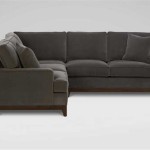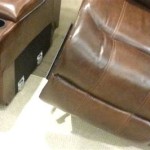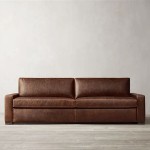Standard Sofa Width
Understanding sofa dimensions is crucial for creating a functional and aesthetically pleasing living space. A key measurement to consider is width, as it dictates how many people can comfortably sit and how the sofa fits within the room's layout. This article explores the standard sofa widths available, factors influencing size choices, and considerations for various living spaces.
While there's no single universally defined "standard" sofa width, certain ranges are commonly produced and sold. These ranges cater to different needs and room sizes. A typical apartment-sized sofa ranges from 72 to 84 inches wide. This size comfortably accommodates two to three people and suits smaller living rooms or apartments.
Mid-sized sofas generally measure between 84 and 96 inches in width. This range provides ample seating for three to four people and works well in medium-sized living rooms or family rooms. Larger sofas, designed for spacious rooms and accommodating five or more individuals, typically exceed 96 inches in width. These can include sectionals, which offer flexible configurations and expansive seating areas.
Beyond these general categories, various other sofa widths exist. Loveseats, designed for intimate seating for two, usually measure between 50 and 70 inches. Oversized sofas, often exceeding 100 inches, cater to large families or those who prioritize expansive lounging space. These measurements provide a general guideline; specific models can vary.
Several factors influence the appropriate sofa width for a given space. Room size is paramount. A large sofa can overwhelm a small room, while a small sofa can appear lost in a large space. Measuring the room and considering traffic flow are essential steps before selecting a sofa.
The intended use of the sofa also plays a significant role. A sofa primarily used for watching movies might prioritize comfort and length, while a sofa in a formal living room might emphasize a smaller, more elegant profile. The number of people the sofa needs to accommodate is another key consideration. Families require larger sofas than individuals or couples.
Existing furniture and the overall room layout also impact sofa width choices. The sofa should complement other furniture pieces and not obstruct walkways or doorways. Consider the placement of other seating, coffee tables, and entertainment centers when determining the optimal sofa width.
Measuring the available space accurately is critical for selecting the right sofa width. Use a tape measure to determine the length and width of the room, as well as the dimensions of existing furniture. Consider not only the sofa's width but also its depth and height to ensure it fits comfortably within the designated space.
Visualizing the sofa in the room can help determine the appropriate size. Use painter's tape to mark out the sofa's dimensions on the floor. This provides a visual representation of the sofa's footprint and helps assess its impact on the room's flow and functionality.
Furniture stores often offer design services or software that can assist with space planning. These tools allow users to create virtual room layouts and experiment with different furniture sizes and configurations. Consulting with a design professional can provide personalized guidance and ensure the chosen sofa width complements the overall design scheme.
Beyond width, other sofa dimensions contribute to its overall size and fit. Depth, the distance from the front edge of the seat cushion to the back of the sofa, influences seating comfort. A deeper sofa provides a more relaxed seating experience. Height, measured from the floor to the top of the sofa back, affects the sofa's visual presence.
Considering these additional dimensions alongside width ensures the sofa fits comfortably within the room and provides the desired level of comfort and functionality. Careful consideration of these factors contributes significantly to creating a well-balanced and inviting living space.
Different sofa styles also influence the relationship between perceived size and actual dimensions. A sofa with a high back and rolled arms can appear larger than a sofa with a low back and sleek arms, even if their widths are similar. Consider the sofa's style and how it contributes to the overall aesthetic when evaluating size.
Understanding standard sofa widths and the factors influencing size selection empowers informed decisions. By carefully considering room size, intended use, existing furniture, and other relevant factors, individuals can choose a sofa that optimizes both comfort and functionality within their living spaces.

Sofa Dimensions 101 Measuring For Your Perfect

Image Result For Standard Size Of Sofa In Mm Cool Couches Furniture Details Design

Standard Sofa Dimensions For 2 3 4 And 5 Person Charts Diagrams Engineering Discoveries

Sofa Size Calculator

Tub Dimensions Inches Sofa Bed Size Small

Sofa Dimensions For 2 3 4 5 6 Person Couches Diagrams Included Home Stratosphere
Your Guide To Measuring For Sofa

Sofa Design Ideas Choose Right For Your Living Room

Sofa Dimensions A Ultimate Guide Homenish Layout Furniture Standard

Farina Sofa Steel Grey Urban Ladder








